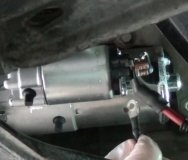Where are you when you hear the relay click? You won't hear the starter relay inside the van. The Automatic Shutdown (ASD) relay and fuel pump relay will click at about the same time and you won't be able to tell them apart. They all make a very light tick.
If you're hearing a kind of loud clunk from the starter, the solenoid contacts are worn. This is real common, and will often not show up on a bench test due to the much lower current they must pass when the motor is not under load. The higher current required to spin the engine can't get through the worn solenoid contacts. It will eventually crank if you cycle the ignition switch to "start" enough times.
A fast way to diagnose this is to pop the cover off the starter relay, reinstall it, and watch the contacts when a helper turns the ignition switch. You can also squeeze the contact by hand. If it cranks, that proves the starter motor, solenoid, and high-current wiring are ok.
If the relay does not click when turning the ignition switch, there are two possibilities. The most common cause is a broken cam on the end of the ignition switch cylinder. It will turn far enough to turn on the dash lights but not far enough to hit the "crank" contact. The dealership parts department has a repair kit.
The other problem is caused by the neutral safety switch. Unfortunately, instead of continuing to use the very simple and reliable switch, the engineers for some bizarre reason have built it into the engine computer.
To determine the cause of why the relay does not click, you'll need to measure voltages in the relay socket. Terminals # 85 and 86 are for the relay's coil. They are the two parallel terminals on the sides of the relay. Terminal 86 must have 12 volts when the ignition switch is in the "crank" position. If it's missing, remove the switch cylinder to inspect the cam on the end. If the voltage is present, you'll need to measure on pin 85, but the relay must be installed. Due to the electronic circuitry in the computer, I don't think you can use an ohm meter to check for continuity as you could easily do with the old reliable switches. If voltage appears on terminal 85 during cranking, it's not getting grounded by the computer. The "PRNDL" switch will need to be checked first, but I did have one, (still under warranty at the time), that had a defective computer.
If you can see the relay click, but the starter solenoid doesn't engage, there are another two circuits to check. Disregard terminals 85 and 86, and the center terminal if used. That leaves terminals 30 and 87 that form the letter "T". Terminal # 30 is the bottom of the "T". It must have 12 volts all the time. If it's missing, check the 40 amp fuse # 5. An ohm meter should read only a few ohms on terminal 87 to ground. That terminal is the top of the "T". If the circuit is open, the solenoid on the starter is open or there's a problem in the wire to it.
If the relay clicks and all four circuits at the relay socket check correctly, measure the voltage on the smaller terminal on the starter when the ignition switch is in "crank. If 12 volts appears there, but the solenoid still doesn't engage with a loud clunk, suspect one of the two windings is open. It only takes one good winding to make the circuit check good, but it takes both windings to make a strong enough magnetic field to engage the solenoid plunger. This can also allow the starter to work on a bench test.
Caradiodoc
Monday, January 18th, 2010 AT 4:08 AM


